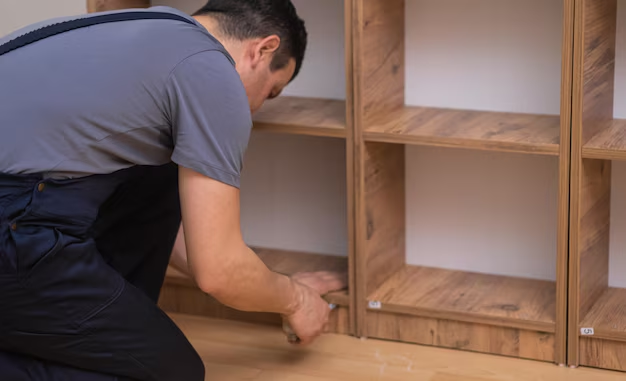Creating a Custom Refrigerator Cabinet: Transform Your Kitchen Space
Imagine transforming your kitchen into a seamless blend of style and practicality. Creating a custom refrigerator cabinet not only provides more efficient use of space but also enhances the aesthetic appeal of your kitchen. Whether you're adding an artistic touch to your home or maximizing storage, building a cabinet for your refrigerator can be a satisfying DIY project. In this guide, we will explore every aspect of how to build a refrigerator cabinet, equipped with practical tips and considerations.
📐 Understanding the Basics: Why Build a Cabinet?
Building a refrigerator cabinet may initially seem like a daunting task. However, understanding the benefits can be motivating:
- Aesthetic Enhancement: Custom cabinets allow your refrigerator to fit seamlessly with the rest of your kitchen.
- Space Optimization: Utilize every inch wisely, especially if you have a compact kitchen.
- Increased Functionality: Add additional storage above or around the fridge.
- Cost-Effective: Tailor your materials and design according to your budget.
🛠️ Getting Started: Essential Tools and Materials
Before you jump into the construction, gather all necessary tools and materials. Having the right items on hand improves efficiency and safety.
Tools You’ll Need
- Tape Measure: Essential for precise measurements.
- Circular Saw or Miter Saw: For cutting wood.
- Cordless Drill: Simplifies fastening and screwing.
- Screwdriver: Handy for smaller screws and adjustments.
- Level: Ensures your cabinet is straight and even.
- Square: Helps keep your angles correct.
Materials to Gather
- Plywood or MDF (Medium-Density Fiberboard): Dependable for the cabinet body. Choose based on your aesthetic preference and budget.
- Wood Glue: Ensures a solid bond for your joints.
- Screws: Essential for assembling the pieces.
- Wood Finish or Paint: Customize the look of your cabinet.
- Cabinet Hinges and Handles: For door functionality and ease of opening.
🗺️ Mapping Out Your Design: Measurements and Layout
Prior to purchasing any wood, it’s critical to determine your space constraints and design preferences. Follow these steps for success:
Measuring Your Space
- Refrigerator Dimensions: Measure the height, width, and depth of your refrigerator. Add at least 1 inch to each measurement for clearance and ease of installation.
- Kitchen Space: Identify the portion of the kitchen where the cabinet will sit and note any limitations in surrounding space.
Designing the Layout
Decide if you want a cabinet that surrounds the fridge entirely or just on top. Create sketches to visualize the final product, including:
- Style Options: Contemporary, traditional, rustic—choose your preferred design.
- Additional Features: Consider whether you want open shelving or closed cupboards above the fridge.
✏️ Building the Framework: Step-by-Step Assembly Guide
Here’s where we turn vision into reality. Follow this systematic process to create your refrigerator cabinet.
Step 1: Cutting the Pieces
- Use the circular saw to cut the plywood or MDF to the planned dimensions.
- Key components include:
- Side panels
- Top and bottom panels
- Back support panel (optional, for added stability)
Step 2: Assembling the Frame
- Begin with the bottom panel. Attach the side panels using wood glue and screws.
- Ensure corners are square, supported by the use of your square and level.
Step 3: Adding the Top Panel
- Place the top panel onto the frame you’ve created and secure it with screws.
- Double-check alignment with a level.
Step 4: Installing Shelves (if applicable)
- If your design includes shelves above the fridge, measure the space and cut shelves to fit.
- Pre-drill holes and use brackets for adjustable shelving.
🎨 Finishing Touches: Painting and Hardware
Painting and Sealing
- Sand the surfaces to ensure smoothness before applying any finishes.
- Paint or stain your cabinet to match or complement the rest of your kitchen decor.
- Apply a protective finish to guard against moisture and wear.
Adding Hardware
- Choose hinges and handles that suit your style.
- Install the doors using the hinges and attach handles securely.
🚪 Installing the Cabinet: Final Setup and Considerations
After building, you will need to carefully position and secure the cabinet in your kitchen space.
- Placement: Carefully maneuver the cabinet into place around the refrigerator.
- Securing the Cabinet: Attach the cabinet to wall studs to ensure stability.
- Rechecking Measurements: Ensure there’s sufficient clearance for ventilation around the refrigerator to prevent overheating.
🌟 The Art of Details: Tips for Functionality and Design
Maximize both the beauty and utility of your custom refrigerator cabinet with these practical tips:
- Ventilation: Always make sure there's enough space for air to circulate around the fridge.
- Lighting: Consider installing LED lights inside the cabinet for improved visibility.
- Style Consistency: Use paint or finishes that align with other cabinetry for a cohesive look.
- Accessibility: Ensure cabinet doors swing open without obstruction.
🔍 Summary of Key Takeaways
To encapsulate what you’ve learned, here’s a visually engaging summary of steps and tips:
- 📏 Plan and Measure: Prioritize precise measurements for a perfect fit.
- 🛠️ Essential Tools and Materials: Gather everything before starting.
- 📐 Build Framework: Follow a step-by-step approach for assembly.
- 🎨 Finish and Install: Tailor the design to your style.
- 🧰 Ventilation and Stability: Ensure functionality and safety.
By following these steps and applying the tips provided, you’ll create a refrigerator cabinet that doesn’t just look amazing but also adds significant functionality to your kitchen. Embrace this opportunity to inject personal style into your home and enjoy the fruits of your labor.
